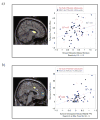Healthy adolescents' neural response to reward: associations with puberty, positive affect, and depressive symptoms
- PMID: 20215938
- PMCID: PMC2837556
- DOI: 10.1097/00004583-201002000-00010
Healthy adolescents' neural response to reward: associations with puberty, positive affect, and depressive symptoms
Abstract
Objective: Changes in reward-related behavior are an important component of normal adolescent affective development. Understanding the neural underpinnings of these normative changes creates a foundation for investigating adolescence as a period of vulnerability to affective disorders, substance use disorders, and health problems. Studies of reward-related brain function have revealed conflicting findings regarding developmental change in the reactivity of the striatum and medial prefrontal cortex (mPFC) and have not considered puberty. The current study focused on puberty-specific changes in brain function and their association with mood.
Method: A sample of 77 healthy adolescents (26 pre-/early pubertal, 51 mid-/late pubertal) recruited in a narrow age range (mean = 11.94 years, SD = 0.75) were assessed for sexual maturation and circulating testosterone, completed a functional magnetic resonance imaging (fMRI) guessing task with monetary reward, and underwent experience sampling of mood in natural environments. For comparison, 19 healthy adults completed the fMRI assessment.
Results: Adolescents with more advanced pubertal maturation exhibited less striatal and more mPFC reactivity during reward outcome than similarly aged adolescents with less advanced maturation. Testosterone was positively correlated with striatal reactivity in boys during reward anticipation and negatively correlated with striatal reactivity in girls and boys during reward outcome. Striatal reactivity was positively correlated with real-world subjective positive affect and negatively correlated with depressive symptoms. mPFC reactivity was positively correlated with depressive symptoms.
Conclusions: Reward-related brain function changes with puberty and is associated with adolescents' positive affect and depressive symptoms. Increased reward-seeking behavior at this developmental point could serve to compensate for these changes.
Figures


References
-
- Nelson EE, Leibenluft E, McClure EB, Pine DS. The social re-orientation of adolescence: a neuroscience perspective on the process and its relation to psychopathology. Psychol Med. 2005 Feb;35(2):163–174. - PubMed
-
- Steinberg L, Albert D, Cauffman E, Banich M, Graham S, Woolard J. Age differences in sensation seeking and impulsivity as indexed by behavior and self-report: Evidence for a dual systems model. Dev Psychol. 2008;44(6):1764–1778. - PubMed
-
- Dahl RE, Spear LP. Adolescent brain development. Ann N Y Acad Sci. 2004;1021:1–22. - PubMed
-
- Davey CG, Yucel M, Allen NB. The emergence of depression in adolescence: development of the prefrontal cortex and the representation of reward. Neurosci Biobehav Rev. 2008;32(1):1–19. - PubMed
Publication types
MeSH terms
Substances
Grants and funding
LinkOut - more resources
Full Text Sources
Medical

